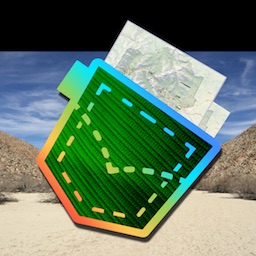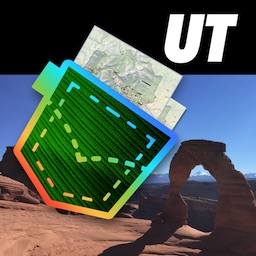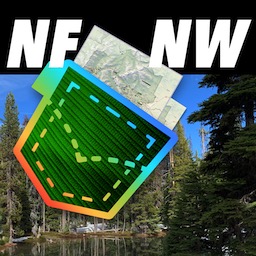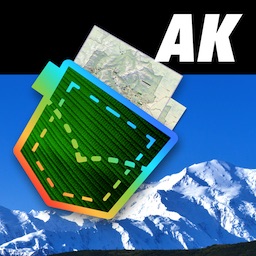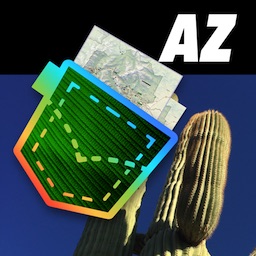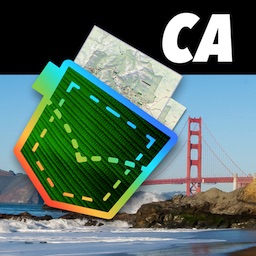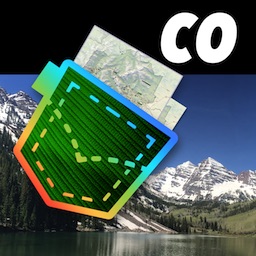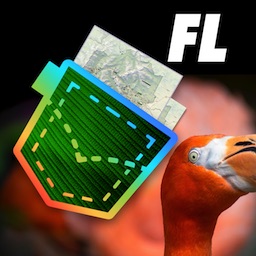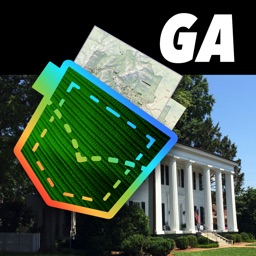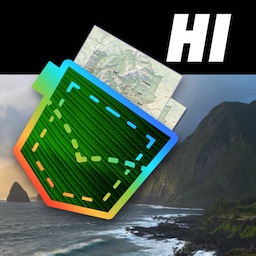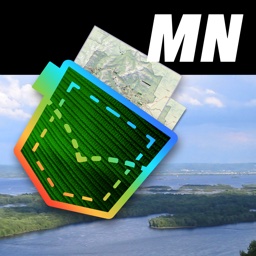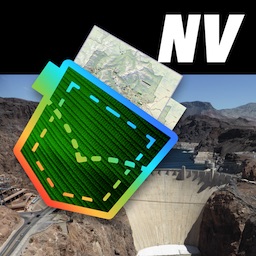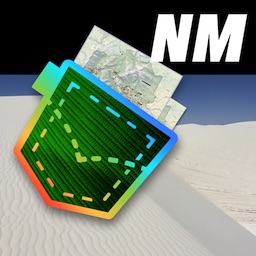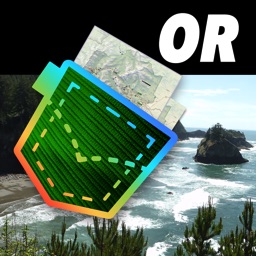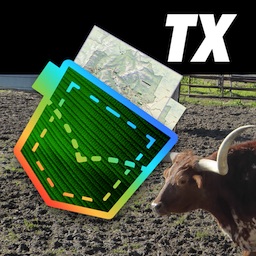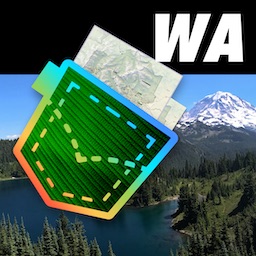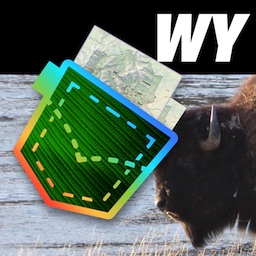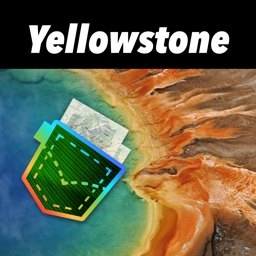by Alex Gugel , all rights reserved
 | Canyonlands GuidesGuide 2021 |
The official newspaper of Canyonlands National Park (NP). Twelve pages of articles and visit recommendations. Includes maps of Island in the Sky and Needles. Published by the National Park Service (NPS).
featured in
| National Parks Pocket Maps |  | |
| Utah Pocket Maps |  |
covered parks
Visitor Guide
National Park Service
U.S. Department of the Interior
Canyonlands National Park
Canyonlands
Pull-out hiking guide inside!
Mesa Arch
NPS / RHODES SMART T
A Lifetime of Exploration Awaits
Canyonlands National Park preserves 337,598 acres of colorful canyons, mesas, buttes, fins, arches, and
spires in the heart of southeast Utah’s high desert. Water and gravity have been the prime architects of this
Horseshoe
Canyon
Green
River
land, sculpting layers of rock into the rugged landscape we see today.
Island
in the
Sky
Colorado
River
Canyonlands preserves that natural beauty and human history throughout its four districts, which are
divided by the Green and Colorado rivers. Island in the Sky is closest to Moab and is the most visited
district. The Needles is a farther drive, and is great for a day trip or backcountry hiking and backpacking.
The Maze is the most remote and rugged district, requiring a four-wheel-drive, high-clearance vehicle, and
more time. The Maze’s Horseshoe Canyon unit contains intriguing rock markings from tribal cultures.
The Maze
The Rivers separate the other three districts and offer world-class boating opportunities.
The Needles
While the districts share a primitive desert atmosphere, each retains its own character and offers different
Cataract
Canyon
opportunities for exploration and adventure. Though they appear close on a map, there are no roads in the
park that directly link the districts. Traveling between them requires two to six hours by car. Check inside
this visitor guide for the best way to plan your visit to Canyonlands.
Welcome to Canyonlands.
Have a safe and enjoyable visit by remembering these rules and advisories.
Drink water. It’s easy to become dehydrated, even
in cold temperatures. Drink at least 1 gallon (4 L)
of water per day. You can get water year-round at
The Needles and Island in the Sky visitor centers,
and seasonally at The Needles Campground.
Do not rely on cell service at Canyonlands.
Much of the park is outside cell phone range. You
may find service where the La Sal Mountains are
visible, but availability will vary by provider.
Respect nature.
Leave plants, rocks, and artifacts where you see
them. Do not feed or disturb animals.
Find your way.
Cairns (small rock piles) mark routes. Don’t build
your own; they could mislead other hikers. If you
get lost, stay where you are, and wait for rescue.
Keep off the arches.
It’s prohibited—and dangerous—to climb or
walk on any arch in the park.
The sun is intense, and shade is rare.
Avoid exertion during peak heat (>90°F /32°C).
Protect yourself with sunscreen, sunglasses,
and a hat.
Preserve natural darkness.
Using artificial light sources to illuminate features
for photography at night is prohibited.
Watch your step.
Rocks fall. People fall. Sandstone is slippery when
wet or icy. In winter, avoid snowy or icy trails.
Leave drones at home. Launching, landing,
or operating unmanned aircraft (such as model
airplanes, quadcopters, or drones) is prohibited.
Leave the rocks as you see them.
Graffiti—carving, scratching, chalking, or any type
of marking—is illegal. Leave no trace.
Walk on hard surfaces.
Stay on trails to protect fragile biological soil crusts
and plant and animal habitat, and to reduce your
risk of getting lost.
Do not use ATVs. It’s prohibited to use any type
of ATV or OHV. There are many roads outside the
park where you can use ATVs and OHVs.
National Park Service
U.S. Department of the Interior
Canyonlands Visitor Guide
2021, vol. 2
Published By
Canyonlands Natural History Association
(CNHA), a nonprofit organization that
assists the National Park Service in its
educational, interpretive, and scientific
programs. For more information, see the
back page.
General Information
i
INFORMATION CENTERS
Canyonlands National Park operates visitor centers year-round at
Island in the Sky and Hans Flat (The Maze), and spring through
fall at The Needles. Hours vary with the season. Many neighboring
communities have information centers with knowledgeable staff,
brochures, and maps.
7
WATER
Canyonlands is in the high desert, and it is easy to become dehydrated,
even in cold temperatures. Plan on drinking at least 1 gallon (4 L) of
water per day. You can get water year-round at The Needles and Island
in the Sky visitor centers and seasonally at The Needles Campground.
Contact Us:
2282 Resource Blvd.
Moab, UT 84532
phone 435-719-2313
email canyinfo@nps.gov
website nps.gov/cany
FOOD, GAS, LODGING, AND OTHER SERVICES
Follow @CanyonlandsNPS
There is no food, gas, lodging, or other amenities at Canyonlands.
Come prepared with adequate food, fuel, and water. These may be
found in nearby towns—see next page for mileage.
Join us to share your park experiences
with us and our growing online
community:
instagram.com/CanyonlandsNPS
The Needles Campground
−
Park Fees
We charge fees for park entrance, camping,
and permits. Eighty percent of your fees
collected at Canyonlands return to the
park to address needs in maintenance,
infrastructure, resource management, and
visitor services. Fees are subject to change.
Entrance Fees
Single vehicle (per vehicle)
$30
Motorcycle (per vehicle)
$25
Pedestrian/Bicycle (per person)
$15
Interagency Annual Pass
$80
Southeast Utah Parks Pass
$55
N P S / C H R I S W O N D E R LY
CAMPING
Campgrounds at The Needles and Island in the Sky have toilets, picnic
tables, and fire rings. The park has no hookups or dump stations.
Maximum length is 28 feet in most sites. Individual sites at Island in
the Sky are first-come, first-served. You can make reservations for
group campsites and some individual sites at The Needles online at
Recreation.gov, or you can call 877-444-6777 (toll free),
877-833-6777 (TTY), or +1 518-885-3639 (international). There are
also many campgrounds outside the park. Both campgrounds have
accessible campsites.
ç
BACKCOUNTRY PERMITS AND RESERVATIONS
You must have a permit for all overnight trips in the backcountry.
If you’re taking a four-wheel-drive, motorcycle, mountain bike, or
e-bike day trip, you must have a day-use permit on Lavender Canyon,
Horse Canyon/Peekaboo, White Rim, and Elephant Hill roads. We
accept reservations for overnight backcountry permits up to four
months in advance, or day-use permits up to one day in advance. You
can reserve permits in advance online at go.nps.gov/canybackcountry.
Permits not reserved in advance may be available first-come, firstserved at park visitor centers.
=
EMERGENCY
If you have an emergency:
Camping Fees (per night)
RANGER PROGRAMS
Rangers typically offer evening programs and overlook talks April
through October as staffing allows. Check the visitor center or website
for up to date schedules. Programs are always subject to change.
Canyonlands experiences wide temperature fluctuations, sometimes
over 40 degrees in a single day. Summer temperatures often exceed
100°F (37°C). Late summer monsoons bring violent storms, which
often cause flash floods. Severe lightning occurs here. Winters
(November through March) are cold, with highs averaging 30° to 50°F
(0° to 10°C), and lows averaging 0° to 20°F (-17° to -6°C).
twitter.com/CanyonlandsNPS
youtube.com/CanyonlandsNPS
"
Island in the Sky Campground
Individual Sites
$15
• Contact a park employee.
The Needles Campground
Individual Sites
$20
• Go to a visitor center. If the building is closed, use the pay phones
in front of the building to dial 911 (no coin needed).
Needles Group Sites
price depends on group size
$70 to
$225
• If service is available, dial 911 on your cell phone. However,
there are many areas without cell coverage in Canyonlands.
ô
ACCESSIBILITY
At Island in the Sky and The Needles, people with mobility
impairments can access visitor centers, toilets, and campgrounds.
We hold campsites for people with disabilities at both campgrounds.
Grand View Point, Green River, and Buck Canyon overlooks (Island
in the Sky) and Wooden Shoe Arch Overlook (The Needles) are
wheelchair accessible. Other points of interest may be accessible with
some assistance.
People with visual impairments can ask at a visitor center for largeprint, braille, and audio described editions of the park brochure.
Movies at visitor centers are captioned for people who are deaf or
have hearing loss.
Service animals, dogs or horses trained to perform specific tasks for
a person with a disability, are allowed on trails and in the backcountry.
Emotional support (“therapy”) animals are not considered service
animals by the Americans with Disabilities Act.
`
TRAVELING WITH PETS
Activities with pets are limited at Canyonlands. Pets must be on a leash
at all times when outside a vehicle. The desert can be deadly for pets
left in cars. You should not leave pets in the car when temperatures
are above 65°F (18°C), even with the windows open.
You may have your pet with you:
• at developed campgrounds in Island in the Sky and The Needles
• along paved roads
• in your vehicle on the Potash/Shafer Canyon road between
Moab and Island in the Sky.
You may not have your pet with you:
• on any hiking trails or overlooks, even if carried
• anywhere in the backcountry including rivers and roads, even if
it’s in your vehicle.
Protect Your Park
Stay on Trails
This land is every bit as fragile as it is beautiful. If you step off the trail, you can easily injure the soil's living surface.
When biological soil crust is damaged, it can take decades to recover.
NPS / NEAL HERBERT
2 Canyonlands Visitor Guide
NPS
WEATHER AND CLIMATE
facebook.com/CanyonlandsNPS
flickr.com/CanyonlandsNPS
Ranger program at Grand View Point
Help us protect park soils during your visit. Please walk on trails, rock, or in sandy washes (where water flows when
it rains), and keep all vehicles and bikes on designated roads. Read more about soil crusts on page 9.
Island in the Sky
435-259-4712 go.nps.gov/isky
The Island in the Sky mesa rests on sheer sandstone cliffs over 1,000 feet above the surrounding
terrain. Each overlook offers a different perspective on the park's spectacular landscape. If you
have a short period of time, Island in the Sky is the easiest district to visit. Many pullouts along
the paved scenic drive offer spectacular views. Hiking trails and four-wheel-drive roads access
backcountry areas for day or overnight trips.
LEARN ABOUT THE PARK
•
DIRECTIONS
On US 191, drive 10 miles (16 km) north of Moab or 22 miles (35 km) south of Interstate 70
(Crescent Junction), then take UT 313 southwest for 22 miles (35 km). Driving time from
Moab is roughly 40 minutes to the visitor center, or 60 minutes to Grand View Point.
•
We may offer ranger programs
at various times, spring
through fall. Check at the
visitor center or campground
for locations, times,
and topics.
Learn about native plants and
their uses on Mesa Arch Trail.
Mesa Arch
NPS
FOR KIDS
BASICS
•
•
•
•
•
The visitor center is open year-round. In January and February, the building is closed
Wednesdays and Thursdays. You’ll find exhibits, book and map sales, backcountry
permits, general information, and park rangers on duty.
Drinking water is available year-round.
You can watch the 15-minute orientation movie Wilderness of Rock at the visitor center.
There are toilets at the visitor center, campground, Grand View Point, Green River
Overlook, Mesa Arch, Upheaval Dome, and White Rim Overlook. The visitor center
toilets are wheelchair accessible.
The campground has 12 sites, first-come, first-served. No water. No hookups. Nightly fee
is $15 per site.
SCENIC DRIVE
You can tour the entire mesa top via the 34-mile roundtrip scenic drive. If you’re looking for
a written guide, you can purchase The Road Guide to Canyonlands - Island in the Sky District
at the visitor center. You can also purchase or rent a self-guiding driving tour CD. Grand View
Point, Green River Overlook, and Buck Canyon Overlook are accessible to wheelchairs.
There are picnic areas at White Rim Overlook, Upheaval Dome, and the visitor center.
Kids can ask for a junior ranger book at any visitor center. Families can also check out an
Explorer Pack filled with activities and supplies to help you have fun in the park (free, one per
family). For hiking, kids enjoy visiting Mesa Arch and climbing the back of the whale at Whale
Rock. Use caution as there are unfenced overlooks and steep drop-offs on both of these trails.
WHAT TO DO WITH YOUR DAY
First, stop at the visitor center for current information on trails, roads, ranger programs,
weather, or to watch the park movie.
In 2 hours you can: Drive to Grand View Point or Green River Overlook. Hike to Mesa Arch.
In 4 hours you can: Drive to Grand View Point, Green River Overlook, and Upheaval Dome.
Hike the Grand View Point, Mesa Arch, and Upheaval Dome Overlook trails.
In 8 hours you can: Visit every overlook. Hike several mesa top trails or one of the more
strenuous trails descending to the White Rim. Enjoy lunch on the trail, or picnic at White Rim
Overlook or Upheaval Dome picnic areas.
Sunrise and Sunset: Visit Mesa Arch at dawn. Visit Green River Overlook or Grand View Point
at dusk for incredible views of sunset over the canyons. Hike to the top of Aztec Butte or Whale
Rock for a spectacular view of Island in the Sky and surrounding countryside.
The Needles
435-259-4711 go.nps.gov/theneedles
The Needles forms the southeast corner of Canyonlands and was named for the colorful spires
of Cedar Mesa Sandstone that dominate the area. The district’s extensive trail system provides
many opportunities for long day hikes and overnight trips.
LEARN ABOUT THE PARK
DIRECTIONS
•
On US 191, drive 40 miles (60 km) south of Moab or 14 miles (22 km) north of Monticello,
then take UT 211 roughly 35 miles (56 km) west. Highway 211 ends in The Needles, and is the
only paved road leading in and out of the area.
•
Take a self-guiding trail at Cave Spring,
Pothole Point, Roadside Ruin,
and Slickrock.
In spring and fall, rangers may present
campfire programs nightly at the
campground. Check at the visitor
center or campground for details.
Chesler Park
N P S / E M I LY O G D E N
BASICS
FOR KIDS
•
Kids can ask for a junior ranger book at
any visitor center. Families can also check out a
Discovery Pack filled with activities and supplies to help you have fun in the park (free, one per
family). The Cave Spring and Pothole Point trails are both popular hikes with kids.
•
•
•
•
The visitor center is open daily, spring through fall. The visitor center is closed in winter.
You’ll find exhibits, book and map sales, general information, picnic area, and
park rangers on duty.
You can get drinking water year-round at the visitor center or spring through fall at
the campground.
You can watch the 15-minute orientation movie, Wilderness of Rock, at the visitor center.
There are restrooms with running water at the visitor center and campground (wheelchair
accessible). There are toilets at Elephant Hill.
The campground has 26 sites available, some sites are available for reservation, and other
sites are first-come, first-served. No hookups. Nightly fee is $20 per site.
WHAT TO DO WITH YOUR DAY
First, stop at the visitor center for current information on trails, roads, ranger programs, weather, or to watch the park movie.
In 2 hours you can: Drive to Big Spring Canyon Overlook, and hike the Pothole Point trail
along the way. Enjoy a picnic and view the Needles from the picnic area.
SCENIC DRIVE
The scenic drive continues 6.5 miles past the visitor center, ending at Big Spring Canyon
Overlook. There are several pullouts for short hiking trails, viewpoints, and a picnic area.
Graded gravel roads lead to Cave Spring and the Elephant Hill trailhead. Get some of the best
views of The Needles on the graded Elephant Hill access road (about one mile from
the pavement).
In 4 hours you can: Explore the scenic drive and graded dirt roads. Hike the Cave Spring,
Pothole Point, and Roadside Ruin trails, or the longer Slickrock trail.
In 8 hours you can: After exploring the scenic drive, hike to Chesler Park Viewpoint or
around the Big Spring–Squaw Canyon loop. Enjoy lunch on the trail.
Sunrise and Sunset: Sunrise is spectacular from the campground area, especially along the
short trail between loops A and B. Visit Pothole Point or Wooden Shoe Arch Overlook to
watch the glow of sunset wash over The Needles.
Canyonlands Visitor Guide 3
The Maze
go.nps.gov/themaze
The Maze is remote, and all roads are
unpaved. You'll need a four-wheel-drive
vehicle, more time, and a greater degree of
self-sufficiency to visit The Maze. Your trip
may take anywhere from three days to a week
or more.
go.nps.gov/canyrivers
The Colorado and Green rivers wind
through the heart of Canyonlands, cutting
through layers of sandstone to form two
deep canyons. The calm waters of these two
rivers join at The Confluence. Below The
Confluence, the combined rivers’ flow spills
down Cataract Canyon with remarkable
speed and power, creating a world-class
stretch of white water.
VISITOR SERVICES
Hans Flat Ranger Station is open daily yearround. It has a small sales area with books
and maps. There are no services, food, gas, or
potable water sources in The Maze. These are
located in Hanksville, 68 miles (109 km), or
Green River, 86 miles (138 km).
NPS / NEAL HERBERT
HORSESHOE CANYON
Horseshoe Canyon contains several
intriguing pictograph panels, including “The Great Gallery,” which features
remarkable life-sized figures and intricate
designs. To visit every panel, plan on a
strenuous roundtrip hike of seven miles.
A trip to Horseshoe Canyon
usually requires a full day.
BACKCOUNTRY TRAVEL
Trails in The Maze are primitive. Many
canyons look alike and are difficult to identify
without a topographic map. You must have
a permit for all overnight trips. Backpackers
stay in at-large zones. Backcountry vehicle
campers and mountain bikers stay in
designated sites and must provide their own
toilet systems.
You can take a flatwater trip down either
NPS / NEAL HERBERT
of the rivers as far as The Confluence or
Spanish Bottom. There are no rapids above
The Confluence in the park, making it an ideal trip for canoes, sea kayaks, and other calmwater boats. Below Spanish Bottom, Cataract Canyon contains 14 miles of rapids ranging in
difficulty from Class II to V. This is a hazardous and isolated section of the Colorado River,
and you should not attempt it unless you’re an experienced boater. There are no facilities or
potable water sources along the rivers in Canyonlands. Your river trip must be self-sufficient,
and you must carry a cleanable, reusable toilet system.
go.nps.gov/horseshoecanyon
PERMITS
M
QUESTIONS?
For the most up-to-date information
on road and trail conditions at The
Maze, call Hans Flat Ranger Station
435-259-2652. (8 am - 4:30 pm)
Backcountry Roads
There are hundreds of miles of four-wheeldrive roads in Canyonlands, providing
access to various campsites, trailheads, and
viewpoints in the park’s backcountry. These
roads range in difficulty from intermediate
to extremely technical. Research your route
thoroughly before attempting. Check for
current conditions at visitor centers.
The Rivers
You must have a permit for all overnight and one-day river trips in Canyonlands. Get your
permit online at go.nps.gov/canybackcountry. We do not restrict launch dates. Maximum group
size is 40 people, though to preserve the wilderness character of the river we recommend
limiting your group size to 16. For more boating information, visit
go.nps.gov/canyrivers.
D*
go.nps.gov/canydriving
If you plan to enjoy the park’s four-wheel-drive roads, please note:
•
•
•
•
•
You must have a high-clearance, four-wheel-drive vehicle (low range) on the White Rim
Road and all Needles and Maze backcountry roads. All-wheel-drive or two-wheel-drive
vehicles are not allowed since they are not equipped to drive on rough
slickrock, loose rocks, deep sand, and steep switchbacks.
You must have a permit for all overnight trips in the backcountry, and for day-use trips on
White Rim, Elephant Hill, Lavender Canyon, and Horse Canyon/Peekaboo roads.
In spring and fall, demand for permits frequently exceeds the number available. If you plan
to visit Canyonlands during peak season, especially to camp along the White Rim Road,
you should make reservations well in advance.
NPS / KIRSTEN KEARSE
All vehicles must remain on established roads and be registered and operated by a licensed driver.
ATVs, OHVs, and Utah State Type I / Type II vehicles are prohibited, even if registered. Motorcycles must be interstate highway legal.
You may take your pets with you on the Potash/Shafer Trail road between Moab and Island in the Sky, but you may not have your pet on the
White Rim Road or any other unpaved road.
Backcountry Roads
Island in the Sky
* D
The White Rim Road loops around and below the Island in the Sky mesa top and provides views of the surrounding area. These 100-mile trips
usually take two to three days by four-wheel-drive vehicle or three to four days by mountain bike. Overnight and day-use permits required.
Elephant Hill
* D
One of the most technical four-wheel-drive roads in Utah. Steep grades, loose rock, stair-step drops, tight turns, and tricky backing. Past the
hill, equally challenging roads lead to various features and BLM lands south of the park. No water at the campsites. There are vault toilets at
all camping areas except New Bates Wilson. If you are camping at New Bates Wilson, you must bring your own toilet. Overnight and day-use
permits required.
Colorado Overlook
* D
Moderate road, can be sandy for mountain bikes. You can avoid the large rocks and stair-step drops in the last 1.5 miles by parking on the
road and walking to the overlook. (Be sure to leave room for other vehicles to pass.) Outstanding views of the Colorado River canyon. Unprotected overlook; use caution. No vehicle camping.
Horse Canyon / Peekaboo
D
Frequently impassable due to quicksand. Roads travel along canyon bottoms where deep sand, deep water, and quicksand are common. Too
sandy for mountain bikes. There are campsites at Peekaboo with prehistoric rock markings and peckings nearby. You must have a portable
toilet at Peekaboo campsite. You may not drive beyond Peekaboo in Salt Creek Canyon. Horse Canyon Road leads to several arches and Tower
Ruin. We recommend traveling in pairs with winch capable, high clearance, four-wheel drive vehicles. Recovery costs are high. Overnight and
day-use permits required.
Lavender Canyon
D
Road follows a canyon bottom where deep sand, deep water, and quicksand are common. Too sandy for mountain bikes. There are major
creek crossings with steep banks. You can view many arches and archeological sites from the road. No vehicle camping inside the park.
Overnight and day-use permits required.
White Rim Road
The Needles
The Maze
Four-wheel-drive roads in The Maze are extremely difficult, present considerable risk of vehicle damage, and should not be attempted by inexperienced drivers. A high-clearance, low-range,
four-wheel-drive vehicle is required for all Maze backcountry roads. (All-wheel-drive vehicles do not have the clearance or low gearing required.) Towing charges are very expensive; visitors in the
backcountry with disabled vehicles can expect towing fees in excess of $2,000. To plan your Maze trip, ask for The Maze backcountry handout in a visitor center or visit go.nps.gov/themaze.
4 Canyonlands Visitor Guide
National Park Service
U.S. Department of the Interior
The Needles Hiking Guide
N P S / J A CO B W . F R A N K
The Needles offers over 60 miles of interconnecting trails, as challenging as they are rewarding.
Many different itineraries are possible, but some of the more popular ones are listed below.
Conditions are primitive. Most trails traverse a mixture of slickrock benches and sandy washes.
Longer trails are especially rough and require negotiating steep passes with drop-offs, narrow
spots, or ladders. Water in the backcountry is unreliable and scarce in some areas. Trails are
marked with cairns (small rock piles). Do not disturb cairns or build new ones.
Although strong hikers can hike most trails in a day, many trails form loops with other trails for
longer trips. Net elevation change is generally several hundred feet or less, except for the Lower
Red Lake Trail, which drops 1,400 feet to the Colorado River.
Remember—help protect park soils during your visit. Please walk on trails, rock, or in sandy
washes (where water flows when it rains).
Trail
Pothole Point
NPS / NEAL HERBERT
On the trail to Chesler Park
NPS
m - toilet at trailhead (no water)
7 - drinking water at trailhead (seasonal)
Distance
(roundtrip)
Average Time
Description
Roadside Ruin
0.3 miles (0.5 km)
20 minutes
A short trail leads to a storage structure built by indigenous people.
Cave Spring
0.6 miles (1.0 km)
45 minutes
This short loop leads to a historic cowboy camp and prehistoric rock markings and peckings. You will climb
two ladders to complete the route.
Pothole Point
0.6 miles (1.0 km)
45 minutes
Uneven slickrock leads to diverse pothole communities and views of The Needles. Trail follows cairns.
Slickrock
2.4 miles (4 km)
1.5 hours
This trail features expansive 360-degree views. Geology guide available. Trail crosses uneven surfaces.
Short
Strenuous
Chesler Park Viewpoint
m
6 miles (10 km)
3 - 4 hours
This popular trail leads to a pass overlooking a scenic expanse of desert grasses and shrubs surrounded by
sandstone spires.
Big Spring Canyon
m
7
7.5 miles (12 km)
3 - 4 hours
A great introduction to the landscape of The Needles, connecting two canyons for a loop across varied
terrain. The route between the canyons climbs steep grades that are dangerous when wet and may make
people with a fear of heights uncomfortable.
m
7
8.7 miles (14 km)
4 - 6 hours
A wonderful loop hike with some difficult sections climbing between the two canyons. Riparian areas in
both canyons attract birds and other wildlife. Route in Lost Canyon passes through dense vegetation and
may be very wet. One ladder must be climbed.
10 miles (16.5 km)
5 - 6 hours
Unlike other Needles hikes, this trail traverses dry, open country along the northern edge of the geologic
faults that shaped the Needles. Trail ends at a cliff overlooking the junction of the Green and Colorado rivers
1,000 (304 m) feet below.
to Squaw Canyon
Squaw Canyon
to Lost Canyon
Confluence Overlook
Peekaboo
m
7
10 miles (16.5 km)
5 - 6 hours
This trail crosses both Squaw and Lost canyons on its way to Salt Creek Canyon, passing along high slickrock
benches with spectacular views. Steep slopes and nearby cliff edges make this a challenging route. Two
ladders must be climbed. View prehistoric rock paintings at the end of the trail near Peekaboo camp.
Big Spring Canyon
10.8 miles (17 km)
4 - 6 hours
to Elephant Canyon
m
7
This loop features extended hiking on slickrock benches and mesa tops overlooking canyons. Excellent views
of sheer cliff walls and other rock formations. You will have to climb two ladders in the pass between the
canyons.
Druid Arch
m
11 miles (18 km)
5 - 7 hours
This trail offers one of the most spectacular views in The Needles. It follows the first part of the Chesler Park
trail, then branches off to travel along the bottom of Elephant Canyon through deep sand and loose rock.
The last 0.25 mile at the upper end is steep with one ladder and some scrambling.
Chesler Park Loop /
Joint Trail
m
11 miles (18 km)
5 - 7 hours
This trail provides many great panoramas of the Needles formations. The Joint Trail winds through deep,
narrow fractures in the rock.
Canyonlands Visitor Guide 5
National Park Service
U.S. Department of the Interior
Island in the Sky Hiking Guide
Several short trails explore the Island in the Sky mesa top with minimal elevation change.
Moderate trails involve elevation, such as climbing a sandstone feature or descending partway
into a canyon. Long trails begin on the mesa top and descend via switchbacks to the White
Rim, or beyond to one of the rivers. These are considered strenuous, with an elevation change
of 1,000-2,000 feet (304-609 m). They require negotiating steep slopes of loose rock as well as
sections of deep sand.
Trails are marked with cairns (small rock piles). Do not disturb existing cairns or build new
ones. There are signs at trailheads and intersections. All trails leading below the mesa top are
primitive and rough. There is no potable water along any of the hiking trails. You can get water
at the visitor center spring through fall.
Fort Bottom Ruin
Aztec Butte
NPS / RHODES SMART T
NPS / NEAL HERBERT
Grand View Point
Trail
Distance
(roundtrip)
Average Time
Description
NPS
m - toilet at trailhead (no water)
Easy - Mesa Top
Mesa Arch
m
0.5 miles (0.8 km)
30 minutes
A short hike leads to a cliff-edge arch. Mesa Arch is a classic sunrise spot, and has stunning views towards the La Sal
Mountains any time of day.
White Rim Overlook
m
1.8 miles (2.8 km)
1.5 hours
Walk to an east-facing overlook for views of the Colorado River, Monument Basin, and La Sal Mountains. Best in late
afternoon. Very limited trailhead parking. Hikers may not park off pavement or in picnic area.
Grand View Point
m
2 miles (3.2 km)
1.5 hours
A stunning out-and-back trail, this walk showcases spectacular panoramic views as it follows the canyon edge.
3.6 miles (5.8 km)
2 hours
This longer hike leads past a historic corral on the mesa top. The trail ends with panoramic views of Candlestick Tower,
the Green River, and the White Rim Road.
Murphy Point
Moderate - Mesa Top
Upheaval Dome
first overlook
m
0.8 miles (1.3 km)
1 hour
A short but steep trail leads to a clear view into Upheaval Dome. Exhibits at the end of the trail discuss this unique
geologic feature.
Upheaval Dome
second overlook
m
1.8 miles (2.9 km)
1.5 hours
This trail splits off from the first overlook trail, following cairns to more views of Upheaval Dome and Upheaval Canyon.
Whale Rock
1 mile (1.6 km)
1 hour
This trail leads up the side of a sandstone dome, ending with broad views of the Island in the Sky. Be careful: steep
drop-offs.
Aztec Butte
2 miles (3.2 km)
1.5 hours
The trail follows a sandy wash, then splits. The eastern fork to your right ascends Aztec Butte for spectacular views.
The western fork on the left climbs the smaller butte then drops below the rim to two ancestral Puebloan granaries.
Both trails require scrambling up slickrock and ledges. Entering, touching, or climbing on archeological sites is strictly
prohibited. View structures from a distance to protect fragile walls.
Neck Spring
5.8 miles (9.3 km)
3 - 4 hours
A walk back in time, this loop trail passes historic ranching features and two springs where cowboys watered cattle.
With minor elevation changes, this trail is a great way to see some varied plant life.
Strenuous - Mesa Top to White Rim
Gooseberry
m
5.4 miles (8.6 km)
4 - 6 hours
Island in the Sky's steepest trail rapidly descends 1,400 feet (427 m) to the White Rim bench. Rough switchbacks cross
sheer cliffs and scree slopes. Step carefully, and don't forget to look up to take in the view.
Syncline Loop
m
8.3 miles (13.3 km)
5 - 7 hours
This challenging trail follows the canyons around Upheaval Dome and requires navigating steep switchbacks, climbing
and scrambling through boulder fields, and a 1,300-foot (396 m) elevation change. Most park rescues occur on this
trail. Carry a map, extra gallons of water, and a flashlight. Hike this trail clockwise for more afternoon shade.
Murphy Loop
10.8 miles (17.4 km)
5 - 7 hours
A great full-day hike, this trail drops off the side of the mesa top for a 1,400-foot (427 m) elevation change. The trail
offers vast views from the Murphy Hogback, then returns up a wash.
Alcove Spring
11.2 miles (18 km)
